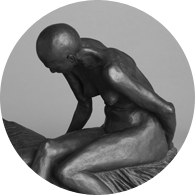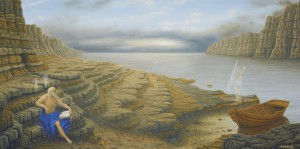(click painting to enlarge)
A limited pallet of colours has been used for effect. The figures are inspired by ‘The appearance of Christ’ Annibale Carracci 1601 and ‘St Jerome’ Guido Reni 1640.
The ravine constricts the open water and along with other divides they represent duality. Smaller divides in the rocks point towards the viewer. One comes from the cave, the other from the boat, with the main figure sitting on that last line.
The boat brought the seeker to this place long a go to meditate on his life experiences. The cave is a hiding place no longer needed. The stark contrast between his flesh and the harsh rocks shows past painful mental struggles, which are a physical reality in the landscape.
A ravine exists between the candles the light from which gives opposite viewpoints when reading his life book. The ravines are made of strata laid down over a long period, each a layer of thought is separate, but joined. The plateaus indicate achievements made using judgement. The landscape has paradoxical elements the sand is pulverised rock, the broken up thoughts previously laid down. The sand appears as one colour but it is made of minute particles of different coloured rocks meaning that duality exists in everything if we look for it.
The candles are burning down and losing their significance in the new vibration. At last he looks up and sees a guide who brings oars and points away from separation towards the part of his mind that will allow further understandings.

